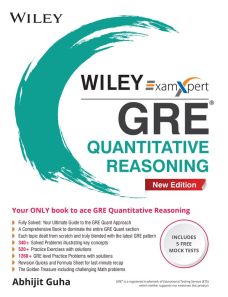Wiley's ExamXpert GRE Quantitative Reasoning
ISBN: 9789354644481
Publication Year: 2023
For more information write to us at: acadmktg@wiley.com

Description
The book is unique that has all the Math basics along with 1800+ practice problems under a single title. This book is fully solved. It is a self-guide for GRE Quant preparation and is a worthy buy.
Acknowledgements
Introduction to GRE
Chapter 1 Arithmetic
Part I: Number Properties
1.1 Real Numbers
1.2 Number Line
1.3 Arithmetic Operations
1.4 Divisibility
1.5 Prime Numbers
1.6 Prime Factorisation
1.7 Factors
1.8 Multiples
1.9 Least Common Multiple
1.10 Highest Common Factor (Greatest Common Divisor)
1.11 Division if not Exactly (Remainder Case)
1.12 Sequence of Numbers
1.13 Approximation
1.14 Estimation
1.15 Average
Part II: Fractions
1.16 Introduction to Fraction
1.17 Simplification of Fractions
1.18 Comparing the Fractions
1.19 Solving Word Problems on Fractions
Part III: Decimals
1.20 Introduction to Decimals
1.21 Place Value of a Decimal System
1.22 Decimal Operations
1.23 Terminating and Non-terminating Decimals
Part IV: Exponents and Roots
1.24 Exponents
1.25 Effect of Exponent Increase
1.26 Effect of Increasing Base
1.27 Simplification of Exponential Expression
1.28 Fractional Exponents
1.29 Square Roots
1.30 Rules of Square Root Operation
1.31 Other Roots of a Number
1.32 Operations with Roots
1.33 Type of Roots
Part V: Percents
1.34 Introduction
1.35 Conversion of Percent, Decimal and Fraction
1.36 Finding p% of a Number
1.37 Finding x is What Percent of y
1.38 Percent Increase and Decrease
1.39 Successive Percent
1.40 Percent: More or Less
1.41 Applications of Percent
Part VI: Ratio
1.42 Introduction to Ratio
1.43 Proportion
Part VII: Rates
1.44 Rate and Work
1.45 Efficiency of a Person
1.46 Multiple Workers
1.47 Rate and Distance
1.48 Average Speed
1.49 Relative Speed
1.50 Trains
Chapter 2 Algebra
Part I: Algebraic Expressions
2.1 Introduction
2.2 Operations in Algebraic Expressions
2.3 Factoring an Algebraic Expression
2.4 Evaluating an Algebraic Expression
Part II: Linear and Quadratic Equations
2.5 Introduction
2.6 Linear Equation in One Variable
2.7 Types of Linear Equation
2.8 Linear Equations in Two Variables
2.9 Quadratic Equation
Part III: Linear and Quadratic Inequalities
2.10 Introduction
2.11 Rules for Solving Inequality
2.12 Linear Inequalities
2.13 Quadratic Inequality
Part IV: Algebraic Translation of Word Problems
2.14 Introduction
2.15 Methods of Solving Word Problems
2.16 Writing Equations
2.17 Topics in Word Problems
Part V: Square Roots, Radicals and Exponents
2.18 Square Roots
2.19 Radicals
2.20 Exponents
Part VI: Functions
2.21 Relation
2.22 Function
2.23 Inverse of a Function
2.24 Defined Functions
2.25 Evaluating a Function
2.26 Composition of Functions
Part VII: Co-ordinate Geometry
2.27 xy-Plane and Quadrants
2.28 Distance Between Two Points
2.29 Straight Line
2.30 Parallel and Perpendicular Lines
2.31 Mid-Point Formula
2.32 Area of Triangle
2.33 Graphs of Functions
Chapter 3 Geometry
Part I: Lines and Angles
3.1 Lines
3.2 Angles
3.3 Rules on Lines and Angles
3.4 Matter of Two Angles
3.5 Transversal
Part II: Triangles
3.6 Introduction
3.7 Classification of Triangles
3.8 Rules for Triangle
3.9 Special Right Triangles
3.10 Area and Perimeter of Triangle
3.11 Congruent and Similar Figures
Part III: Quadrilaterals
3.12 Introduction
3.13 Type of Quadrilaterals
3.14 Perimeter and Area
Part IV: Polygons
3.15 Introduction
3.16 Interior Angles
3.17 Exterior Angles
3.18 Regular Polygon
Part V: Circles
3.19 Introduction
3.20 Basic Elements in a Circle
3.21 Angles Inside a Circle
3.22 Important Theorems on Angles Inside a Circle
3.23 Theorems on Two Intersecting Chords
3.24 Tangent
3.25 Sector
3.26 Circumscribed and Inscribed Polygons
Part VI: 3D Solids
3.27 Rectangular Solids (Cuboids)
3.28 Cube
3.29 Cylinder
3.30 Cone
3.31 Pyramid
3.32 Sphere
Chapter 4 Data Analysis
Part I: Descriptive Statistics
4.1 Mean
4.2 Median
4.3 Mode
4.4 Quartile
4.5 Percentile
4.6 Range
4.7 Standard Deviation
Part II: Permutation and Combination
4.8 Basics for GRE
4.9 Fundamental Counting Principle (FCP)
4.10 Permutation
4.11 Combination
Part III: Set Theory and Venn Diagram
4.12 Introduction
4.13 Two Sets
4.14 Venn Diagrams
4.15 Venn Diagram and Word Problems
Part IV: Probability
4.16 Introduction
4.17 Simple Probability (Single Event)
4.18 Compound Probability (For Multiple Events)
4.19 Application of Various Concepts for Calculating Probability
4.20 Conditional Probability
Part V: Data Interpretation
4.21 Introduction to Data Interpretation
4.22 Tables
4.23 Bar Graphs
4.24 Line Graphs
4.25 Pie Graphs
4.26 Scatter Plots
4.27 Histograms
4.28 Normal Distributions
Practice Exercise
Part V
Practice Problems
Answer Key
Answers with Explanations
Mock Tests
Mock Test 1
Mock Test 2
Mock Test 3
Mock Test 4
Mock Test 5
Answer Key
Answers with Explanations
Golden Treasure
Problems
Answer Key
Answers with Explanations
Revision Quicks
Arithmetic
Numbers
Fractions
Divisibility Rules for Natural Numbers
Factors
Roots and Exponents
Decimals
Average
Ratio
Proportion
Variation
Rate
Percent
Profit
Simple Interest
Algebra
Foil
Factoring
Equations
Inequality
Word Problems
Functions
Co-ordinate Geometry
Geometry
Angles
Data Interpretation
Set Theory Formula
Statistics Formula
Permutation Formula
Combination Formula
Probability Formula
Graphs and Tables
Interpretation of Data
Formula Sheet
Arithmetic
Algebra
Geometry
Data Interpretation

